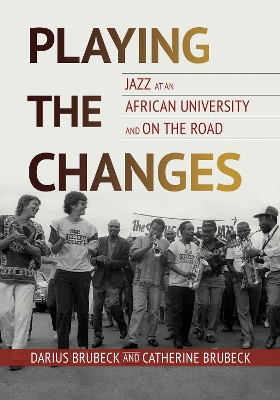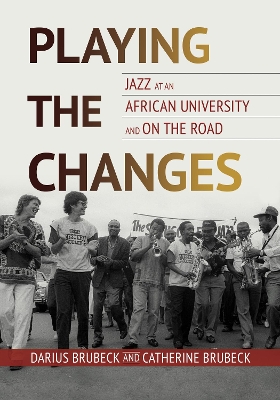Classroom Guide to Jazz Improvisation
 -10%
portes grátis
-10%
portes grátis
Classroom Guide to Jazz Improvisation
Nielsen, Ryan; McNeil, John
Oxford University Press Inc
07/2024
168
Mole
Inglês
9780197614655
Pré-lançamento - envio 15 a 20 dias após a sua edição
Descrição não disponível.
Chapter 1 Getting Started
Everyone Can Improvise
Training the Subconscious to Make Choices
Beyond Rote Memory
How to Use This Book
Tips for Getting Started
Reconsidering Beginning with the Blues
Chapter 2 Basic Concepts: The Root Triad and Jazz Rhythms
Chord Versus Scale
Reading Jazz Chord Symbols
Lesson Plan 1: Improvising on the Root Triad
Rhythm Section Tips
Lesson Plan 2: Adding Rhythm
Teacher's Notes
Why Start with the Root Triad?
Choosing Chords to Begin With
Adjusting Range
Designing Rhythm
Rhythm Section
General Tips
Piano: Basic Voicings
Guitar: Basic Voicings
Bass: Walking Bass Lines with Triad Pitches
Drums: Basic Ride Cymbal Technique, Hi-Hat Usage, and Kicks
Chapter 3 Adding the 2nd (1-2-3-5)
Lesson Plan 3: Adding the 2nd Degree
Lesson Plan 4: Building Longer 8th-Note Lines
Teachers' Notes
Other Possibilities on 1-2-3-5
Moving from Chord to Chord
The Metronome in Rehearsal
Tunes to Begin With
More Advanced Rhythms (3/4 + 2/4)
Chapter 4: Approaching Chord Tones from Below
Lesson Plan 5: Approach Tones (Half-Step-Below)
Teacher's Notes
Upbeats and Anticipation
Different Chord Qualities (Major)
Rhythm Section
Drums: Lightly Kicking the Upbeats
Piano/Guitar: Approaching 3, 5 | 7, 9 Voicings from Below
Chapter 5 Approaching Chord Tones from Above
Lesson Plan 6: Approaching Chord Tones from a Scale Step Above
Lesson Plan 7: 8th-Note Lines with Approach Tones
Teacher's Notes
Rhythm Section
Bass: Adding Approach Tones to Bass Lines
Chapter 6: Approaching Chord Tones by Two Notes
Lesson Plan 8: Two-Note Approach Tones (Above/Below)
Lesson Plan 9: Approaching Chord Tones from Two Notes Above or Two Notes Below
Chapter 7: Approaching Chord Tones by Three or More Notes
Lesson Plan 10: Approaching with Three Notes (Part 1)
Lesson Plan 11: Approaching with Three Notes (Part 2)
Lesson Plan 12: Approaching the 7th
Teacher's Notes
Approaching with Four or Five Notes
Simplifying Three Note Approaches for Less Experienced Students
Chapter 8: Improvising on the Entire Chord/Scale (Part 1)
Lesson Plan 13: Diatonic Thirds
Teacher's Notes
Singing Tetrachords
Adding Syncopation to Diatonic Thirds
More Advanced Use of Thirds
Descending Lines
Rhythm Section
Bass: Using Diatonic Thirds in Bass Lines
Piano: Using Diatonic Thirds in Comping
Chapter 9 Improvising on the Entire Chord/Scale (Part 2): Longer Lines and Harmonic Changes
Lesson Plan 14: Creating Longer Lines with Thirds
Lesson Plan 15: Moving from One Chord/Scale to Another
Chapter 10 General Scale Skills: Triads, 7th Chords, and Other Intervals
Lesson Plan 16: Triads and Other Structures
Lesson Plan 17: Mixing It Up
Teacher's Notes
Organizing Other Structures in the Chord/Scale (7th-Chords, Intervals)
Combining Lessons
Chapter 11: Understanding Chord Symbols and Respelling Chords
First, Chord Symbols
What Is Respelling?
How to Respell
Examples of Respelling
Extra Credit: Parallel Structures
Teacher's Notes
Respelling the Dominant
Respelling the Altered Dominant
Respelling the Half-Diminished Chord
Respelling Lydian
Rhythm Section
Bass: Only Respell When Soloing
Piano/Guitar: Voicing the Altered Dominant, When to Respell
Chapter 12: The II-7 | V7 | Id7 (Part 1) - Using #b7 to 3 to Move from Chord to Chord
Lesson Plan 18: Hearing #b7 to 3 on the II-7 | V7 | Id7
Lesson Plan 19: Using #b7 to 3 to Improvise on a II-7 | V7
Lesson Plan 20: Using #b7 to 3 to Improvise on a V7 | Id7
Lesson Plan 21: Using #b7 to 3 to Improvise on a II-7 | V7 | Id7
Teacher's Notes
Singing Backgrounds
Tips for Building 8th-Note Lines
Rhythm Section
Piano/Guitar: Using Stepwise Motion
Chapter 13 II-7 | V7 | I (Part 2): Melodic Arpeggios and Dominant Cycles
Lesson Plan 22: Towards Improvising on a II-7 | V7 | Id7
Lesson Plan 23: Introducing ##9 and #b9 on the V7 Chord
Lesson Plan 24: Dominant Cycles (Part 1) - 1-2-3-5 and 1-5-3-5
Lesson Plan 25: Dominant Cycles (Part 2) - 3-5-7-9 Arpeggios
Lesson Plan 26: Dominant Cycles (Part 3) - Adding and Dropping Beats
Lesson Plan 27: 3-5-7-9 + Approach Tones - Dropping and Adding Beats
on a II-7 | V7 | Id7
Chapter 14: Playing the Blues (Part 1)
Why We Didn't Start with the Blues
What the Blues Means to Us
Lesson Plan 28: Using Approach Tones to Hear the Harmonic Form of the Blues (Less Advanced)
Lesson Plan 29: 1-2-3-5 on the Blues (Less Advanced)
Teacher's Notes
Harmonic Options on the Blues
The Turnaround
Rhythm Section
Piano: An Example of Comping on the Blues
Chapter 15: The Vocal Form of the Blues
Lesson Plan 30: Introducing the Vocal Form of the Blues (Less Advanced)
Lesson Plan 31: Instrumental Blues (Part 1 - Less Advanced)
Lesson Plan 32: Instrumental Blues (Part 2 - Less Advanced)
Lesson Plan 33: Instrumental Blues (Part 3 - More Advanced)
List of Blues Tunes
Teacher's Notes
Rhythm Section
Recommended Blues Tracks for Piano
Chapter 16: A Guide to Transcribing (Learning by Ear)
Getting Started
Make It Their Own
A Few Examples of Creative Practice Inspired by Transcribing
Chapter 17: The Benefits of Play - Why We Teach Jazz
A Word About a Word: Play
The Effects of Jazz: Talking Points for Admin and Parents
Appendix: Chord Symbols
Index
Everyone Can Improvise
Training the Subconscious to Make Choices
Beyond Rote Memory
How to Use This Book
Tips for Getting Started
Reconsidering Beginning with the Blues
Chapter 2 Basic Concepts: The Root Triad and Jazz Rhythms
Chord Versus Scale
Reading Jazz Chord Symbols
Lesson Plan 1: Improvising on the Root Triad
Rhythm Section Tips
Lesson Plan 2: Adding Rhythm
Teacher's Notes
Why Start with the Root Triad?
Choosing Chords to Begin With
Adjusting Range
Designing Rhythm
Rhythm Section
General Tips
Piano: Basic Voicings
Guitar: Basic Voicings
Bass: Walking Bass Lines with Triad Pitches
Drums: Basic Ride Cymbal Technique, Hi-Hat Usage, and Kicks
Chapter 3 Adding the 2nd (1-2-3-5)
Lesson Plan 3: Adding the 2nd Degree
Lesson Plan 4: Building Longer 8th-Note Lines
Teachers' Notes
Other Possibilities on 1-2-3-5
Moving from Chord to Chord
The Metronome in Rehearsal
Tunes to Begin With
More Advanced Rhythms (3/4 + 2/4)
Chapter 4: Approaching Chord Tones from Below
Lesson Plan 5: Approach Tones (Half-Step-Below)
Teacher's Notes
Upbeats and Anticipation
Different Chord Qualities (Major)
Rhythm Section
Drums: Lightly Kicking the Upbeats
Piano/Guitar: Approaching 3, 5 | 7, 9 Voicings from Below
Chapter 5 Approaching Chord Tones from Above
Lesson Plan 6: Approaching Chord Tones from a Scale Step Above
Lesson Plan 7: 8th-Note Lines with Approach Tones
Teacher's Notes
Rhythm Section
Bass: Adding Approach Tones to Bass Lines
Chapter 6: Approaching Chord Tones by Two Notes
Lesson Plan 8: Two-Note Approach Tones (Above/Below)
Lesson Plan 9: Approaching Chord Tones from Two Notes Above or Two Notes Below
Chapter 7: Approaching Chord Tones by Three or More Notes
Lesson Plan 10: Approaching with Three Notes (Part 1)
Lesson Plan 11: Approaching with Three Notes (Part 2)
Lesson Plan 12: Approaching the 7th
Teacher's Notes
Approaching with Four or Five Notes
Simplifying Three Note Approaches for Less Experienced Students
Chapter 8: Improvising on the Entire Chord/Scale (Part 1)
Lesson Plan 13: Diatonic Thirds
Teacher's Notes
Singing Tetrachords
Adding Syncopation to Diatonic Thirds
More Advanced Use of Thirds
Descending Lines
Rhythm Section
Bass: Using Diatonic Thirds in Bass Lines
Piano: Using Diatonic Thirds in Comping
Chapter 9 Improvising on the Entire Chord/Scale (Part 2): Longer Lines and Harmonic Changes
Lesson Plan 14: Creating Longer Lines with Thirds
Lesson Plan 15: Moving from One Chord/Scale to Another
Chapter 10 General Scale Skills: Triads, 7th Chords, and Other Intervals
Lesson Plan 16: Triads and Other Structures
Lesson Plan 17: Mixing It Up
Teacher's Notes
Organizing Other Structures in the Chord/Scale (7th-Chords, Intervals)
Combining Lessons
Chapter 11: Understanding Chord Symbols and Respelling Chords
First, Chord Symbols
What Is Respelling?
How to Respell
Examples of Respelling
Extra Credit: Parallel Structures
Teacher's Notes
Respelling the Dominant
Respelling the Altered Dominant
Respelling the Half-Diminished Chord
Respelling Lydian
Rhythm Section
Bass: Only Respell When Soloing
Piano/Guitar: Voicing the Altered Dominant, When to Respell
Chapter 12: The II-7 | V7 | Id7 (Part 1) - Using #b7 to 3 to Move from Chord to Chord
Lesson Plan 18: Hearing #b7 to 3 on the II-7 | V7 | Id7
Lesson Plan 19: Using #b7 to 3 to Improvise on a II-7 | V7
Lesson Plan 20: Using #b7 to 3 to Improvise on a V7 | Id7
Lesson Plan 21: Using #b7 to 3 to Improvise on a II-7 | V7 | Id7
Teacher's Notes
Singing Backgrounds
Tips for Building 8th-Note Lines
Rhythm Section
Piano/Guitar: Using Stepwise Motion
Chapter 13 II-7 | V7 | I (Part 2): Melodic Arpeggios and Dominant Cycles
Lesson Plan 22: Towards Improvising on a II-7 | V7 | Id7
Lesson Plan 23: Introducing ##9 and #b9 on the V7 Chord
Lesson Plan 24: Dominant Cycles (Part 1) - 1-2-3-5 and 1-5-3-5
Lesson Plan 25: Dominant Cycles (Part 2) - 3-5-7-9 Arpeggios
Lesson Plan 26: Dominant Cycles (Part 3) - Adding and Dropping Beats
Lesson Plan 27: 3-5-7-9 + Approach Tones - Dropping and Adding Beats
on a II-7 | V7 | Id7
Chapter 14: Playing the Blues (Part 1)
Why We Didn't Start with the Blues
What the Blues Means to Us
Lesson Plan 28: Using Approach Tones to Hear the Harmonic Form of the Blues (Less Advanced)
Lesson Plan 29: 1-2-3-5 on the Blues (Less Advanced)
Teacher's Notes
Harmonic Options on the Blues
The Turnaround
Rhythm Section
Piano: An Example of Comping on the Blues
Chapter 15: The Vocal Form of the Blues
Lesson Plan 30: Introducing the Vocal Form of the Blues (Less Advanced)
Lesson Plan 31: Instrumental Blues (Part 1 - Less Advanced)
Lesson Plan 32: Instrumental Blues (Part 2 - Less Advanced)
Lesson Plan 33: Instrumental Blues (Part 3 - More Advanced)
List of Blues Tunes
Teacher's Notes
Rhythm Section
Recommended Blues Tracks for Piano
Chapter 16: A Guide to Transcribing (Learning by Ear)
Getting Started
Make It Their Own
A Few Examples of Creative Practice Inspired by Transcribing
Chapter 17: The Benefits of Play - Why We Teach Jazz
A Word About a Word: Play
The Effects of Jazz: Talking Points for Admin and Parents
Appendix: Chord Symbols
Index
Este título pertence ao(s) assunto(s) indicados(s). Para ver outros títulos clique no assunto desejado.
Chapter 1 Getting Started
Everyone Can Improvise
Training the Subconscious to Make Choices
Beyond Rote Memory
How to Use This Book
Tips for Getting Started
Reconsidering Beginning with the Blues
Chapter 2 Basic Concepts: The Root Triad and Jazz Rhythms
Chord Versus Scale
Reading Jazz Chord Symbols
Lesson Plan 1: Improvising on the Root Triad
Rhythm Section Tips
Lesson Plan 2: Adding Rhythm
Teacher's Notes
Why Start with the Root Triad?
Choosing Chords to Begin With
Adjusting Range
Designing Rhythm
Rhythm Section
General Tips
Piano: Basic Voicings
Guitar: Basic Voicings
Bass: Walking Bass Lines with Triad Pitches
Drums: Basic Ride Cymbal Technique, Hi-Hat Usage, and Kicks
Chapter 3 Adding the 2nd (1-2-3-5)
Lesson Plan 3: Adding the 2nd Degree
Lesson Plan 4: Building Longer 8th-Note Lines
Teachers' Notes
Other Possibilities on 1-2-3-5
Moving from Chord to Chord
The Metronome in Rehearsal
Tunes to Begin With
More Advanced Rhythms (3/4 + 2/4)
Chapter 4: Approaching Chord Tones from Below
Lesson Plan 5: Approach Tones (Half-Step-Below)
Teacher's Notes
Upbeats and Anticipation
Different Chord Qualities (Major)
Rhythm Section
Drums: Lightly Kicking the Upbeats
Piano/Guitar: Approaching 3, 5 | 7, 9 Voicings from Below
Chapter 5 Approaching Chord Tones from Above
Lesson Plan 6: Approaching Chord Tones from a Scale Step Above
Lesson Plan 7: 8th-Note Lines with Approach Tones
Teacher's Notes
Rhythm Section
Bass: Adding Approach Tones to Bass Lines
Chapter 6: Approaching Chord Tones by Two Notes
Lesson Plan 8: Two-Note Approach Tones (Above/Below)
Lesson Plan 9: Approaching Chord Tones from Two Notes Above or Two Notes Below
Chapter 7: Approaching Chord Tones by Three or More Notes
Lesson Plan 10: Approaching with Three Notes (Part 1)
Lesson Plan 11: Approaching with Three Notes (Part 2)
Lesson Plan 12: Approaching the 7th
Teacher's Notes
Approaching with Four or Five Notes
Simplifying Three Note Approaches for Less Experienced Students
Chapter 8: Improvising on the Entire Chord/Scale (Part 1)
Lesson Plan 13: Diatonic Thirds
Teacher's Notes
Singing Tetrachords
Adding Syncopation to Diatonic Thirds
More Advanced Use of Thirds
Descending Lines
Rhythm Section
Bass: Using Diatonic Thirds in Bass Lines
Piano: Using Diatonic Thirds in Comping
Chapter 9 Improvising on the Entire Chord/Scale (Part 2): Longer Lines and Harmonic Changes
Lesson Plan 14: Creating Longer Lines with Thirds
Lesson Plan 15: Moving from One Chord/Scale to Another
Chapter 10 General Scale Skills: Triads, 7th Chords, and Other Intervals
Lesson Plan 16: Triads and Other Structures
Lesson Plan 17: Mixing It Up
Teacher's Notes
Organizing Other Structures in the Chord/Scale (7th-Chords, Intervals)
Combining Lessons
Chapter 11: Understanding Chord Symbols and Respelling Chords
First, Chord Symbols
What Is Respelling?
How to Respell
Examples of Respelling
Extra Credit: Parallel Structures
Teacher's Notes
Respelling the Dominant
Respelling the Altered Dominant
Respelling the Half-Diminished Chord
Respelling Lydian
Rhythm Section
Bass: Only Respell When Soloing
Piano/Guitar: Voicing the Altered Dominant, When to Respell
Chapter 12: The II-7 | V7 | Id7 (Part 1) - Using #b7 to 3 to Move from Chord to Chord
Lesson Plan 18: Hearing #b7 to 3 on the II-7 | V7 | Id7
Lesson Plan 19: Using #b7 to 3 to Improvise on a II-7 | V7
Lesson Plan 20: Using #b7 to 3 to Improvise on a V7 | Id7
Lesson Plan 21: Using #b7 to 3 to Improvise on a II-7 | V7 | Id7
Teacher's Notes
Singing Backgrounds
Tips for Building 8th-Note Lines
Rhythm Section
Piano/Guitar: Using Stepwise Motion
Chapter 13 II-7 | V7 | I (Part 2): Melodic Arpeggios and Dominant Cycles
Lesson Plan 22: Towards Improvising on a II-7 | V7 | Id7
Lesson Plan 23: Introducing ##9 and #b9 on the V7 Chord
Lesson Plan 24: Dominant Cycles (Part 1) - 1-2-3-5 and 1-5-3-5
Lesson Plan 25: Dominant Cycles (Part 2) - 3-5-7-9 Arpeggios
Lesson Plan 26: Dominant Cycles (Part 3) - Adding and Dropping Beats
Lesson Plan 27: 3-5-7-9 + Approach Tones - Dropping and Adding Beats
on a II-7 | V7 | Id7
Chapter 14: Playing the Blues (Part 1)
Why We Didn't Start with the Blues
What the Blues Means to Us
Lesson Plan 28: Using Approach Tones to Hear the Harmonic Form of the Blues (Less Advanced)
Lesson Plan 29: 1-2-3-5 on the Blues (Less Advanced)
Teacher's Notes
Harmonic Options on the Blues
The Turnaround
Rhythm Section
Piano: An Example of Comping on the Blues
Chapter 15: The Vocal Form of the Blues
Lesson Plan 30: Introducing the Vocal Form of the Blues (Less Advanced)
Lesson Plan 31: Instrumental Blues (Part 1 - Less Advanced)
Lesson Plan 32: Instrumental Blues (Part 2 - Less Advanced)
Lesson Plan 33: Instrumental Blues (Part 3 - More Advanced)
List of Blues Tunes
Teacher's Notes
Rhythm Section
Recommended Blues Tracks for Piano
Chapter 16: A Guide to Transcribing (Learning by Ear)
Getting Started
Make It Their Own
A Few Examples of Creative Practice Inspired by Transcribing
Chapter 17: The Benefits of Play - Why We Teach Jazz
A Word About a Word: Play
The Effects of Jazz: Talking Points for Admin and Parents
Appendix: Chord Symbols
Index
Everyone Can Improvise
Training the Subconscious to Make Choices
Beyond Rote Memory
How to Use This Book
Tips for Getting Started
Reconsidering Beginning with the Blues
Chapter 2 Basic Concepts: The Root Triad and Jazz Rhythms
Chord Versus Scale
Reading Jazz Chord Symbols
Lesson Plan 1: Improvising on the Root Triad
Rhythm Section Tips
Lesson Plan 2: Adding Rhythm
Teacher's Notes
Why Start with the Root Triad?
Choosing Chords to Begin With
Adjusting Range
Designing Rhythm
Rhythm Section
General Tips
Piano: Basic Voicings
Guitar: Basic Voicings
Bass: Walking Bass Lines with Triad Pitches
Drums: Basic Ride Cymbal Technique, Hi-Hat Usage, and Kicks
Chapter 3 Adding the 2nd (1-2-3-5)
Lesson Plan 3: Adding the 2nd Degree
Lesson Plan 4: Building Longer 8th-Note Lines
Teachers' Notes
Other Possibilities on 1-2-3-5
Moving from Chord to Chord
The Metronome in Rehearsal
Tunes to Begin With
More Advanced Rhythms (3/4 + 2/4)
Chapter 4: Approaching Chord Tones from Below
Lesson Plan 5: Approach Tones (Half-Step-Below)
Teacher's Notes
Upbeats and Anticipation
Different Chord Qualities (Major)
Rhythm Section
Drums: Lightly Kicking the Upbeats
Piano/Guitar: Approaching 3, 5 | 7, 9 Voicings from Below
Chapter 5 Approaching Chord Tones from Above
Lesson Plan 6: Approaching Chord Tones from a Scale Step Above
Lesson Plan 7: 8th-Note Lines with Approach Tones
Teacher's Notes
Rhythm Section
Bass: Adding Approach Tones to Bass Lines
Chapter 6: Approaching Chord Tones by Two Notes
Lesson Plan 8: Two-Note Approach Tones (Above/Below)
Lesson Plan 9: Approaching Chord Tones from Two Notes Above or Two Notes Below
Chapter 7: Approaching Chord Tones by Three or More Notes
Lesson Plan 10: Approaching with Three Notes (Part 1)
Lesson Plan 11: Approaching with Three Notes (Part 2)
Lesson Plan 12: Approaching the 7th
Teacher's Notes
Approaching with Four or Five Notes
Simplifying Three Note Approaches for Less Experienced Students
Chapter 8: Improvising on the Entire Chord/Scale (Part 1)
Lesson Plan 13: Diatonic Thirds
Teacher's Notes
Singing Tetrachords
Adding Syncopation to Diatonic Thirds
More Advanced Use of Thirds
Descending Lines
Rhythm Section
Bass: Using Diatonic Thirds in Bass Lines
Piano: Using Diatonic Thirds in Comping
Chapter 9 Improvising on the Entire Chord/Scale (Part 2): Longer Lines and Harmonic Changes
Lesson Plan 14: Creating Longer Lines with Thirds
Lesson Plan 15: Moving from One Chord/Scale to Another
Chapter 10 General Scale Skills: Triads, 7th Chords, and Other Intervals
Lesson Plan 16: Triads and Other Structures
Lesson Plan 17: Mixing It Up
Teacher's Notes
Organizing Other Structures in the Chord/Scale (7th-Chords, Intervals)
Combining Lessons
Chapter 11: Understanding Chord Symbols and Respelling Chords
First, Chord Symbols
What Is Respelling?
How to Respell
Examples of Respelling
Extra Credit: Parallel Structures
Teacher's Notes
Respelling the Dominant
Respelling the Altered Dominant
Respelling the Half-Diminished Chord
Respelling Lydian
Rhythm Section
Bass: Only Respell When Soloing
Piano/Guitar: Voicing the Altered Dominant, When to Respell
Chapter 12: The II-7 | V7 | Id7 (Part 1) - Using #b7 to 3 to Move from Chord to Chord
Lesson Plan 18: Hearing #b7 to 3 on the II-7 | V7 | Id7
Lesson Plan 19: Using #b7 to 3 to Improvise on a II-7 | V7
Lesson Plan 20: Using #b7 to 3 to Improvise on a V7 | Id7
Lesson Plan 21: Using #b7 to 3 to Improvise on a II-7 | V7 | Id7
Teacher's Notes
Singing Backgrounds
Tips for Building 8th-Note Lines
Rhythm Section
Piano/Guitar: Using Stepwise Motion
Chapter 13 II-7 | V7 | I (Part 2): Melodic Arpeggios and Dominant Cycles
Lesson Plan 22: Towards Improvising on a II-7 | V7 | Id7
Lesson Plan 23: Introducing ##9 and #b9 on the V7 Chord
Lesson Plan 24: Dominant Cycles (Part 1) - 1-2-3-5 and 1-5-3-5
Lesson Plan 25: Dominant Cycles (Part 2) - 3-5-7-9 Arpeggios
Lesson Plan 26: Dominant Cycles (Part 3) - Adding and Dropping Beats
Lesson Plan 27: 3-5-7-9 + Approach Tones - Dropping and Adding Beats
on a II-7 | V7 | Id7
Chapter 14: Playing the Blues (Part 1)
Why We Didn't Start with the Blues
What the Blues Means to Us
Lesson Plan 28: Using Approach Tones to Hear the Harmonic Form of the Blues (Less Advanced)
Lesson Plan 29: 1-2-3-5 on the Blues (Less Advanced)
Teacher's Notes
Harmonic Options on the Blues
The Turnaround
Rhythm Section
Piano: An Example of Comping on the Blues
Chapter 15: The Vocal Form of the Blues
Lesson Plan 30: Introducing the Vocal Form of the Blues (Less Advanced)
Lesson Plan 31: Instrumental Blues (Part 1 - Less Advanced)
Lesson Plan 32: Instrumental Blues (Part 2 - Less Advanced)
Lesson Plan 33: Instrumental Blues (Part 3 - More Advanced)
List of Blues Tunes
Teacher's Notes
Rhythm Section
Recommended Blues Tracks for Piano
Chapter 16: A Guide to Transcribing (Learning by Ear)
Getting Started
Make It Their Own
A Few Examples of Creative Practice Inspired by Transcribing
Chapter 17: The Benefits of Play - Why We Teach Jazz
A Word About a Word: Play
The Effects of Jazz: Talking Points for Admin and Parents
Appendix: Chord Symbols
Index
Este título pertence ao(s) assunto(s) indicados(s). Para ver outros títulos clique no assunto desejado.







